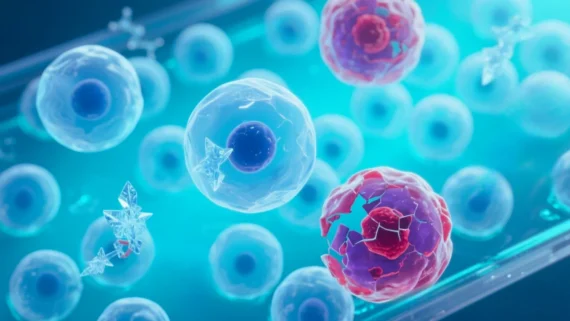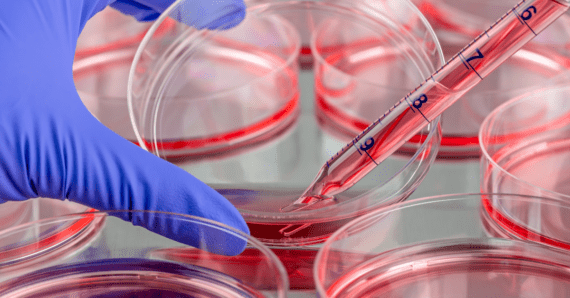Cell culture success hinges on precision, yet it’s plagued by persistent myths. Despite advancements in technology, misconceptions continue to hinder research progress. From media selection and FBS optimisation to contamination control, these misunderstandings can lead to unreliable results, wasted resources, and compromised data integrity.
In this blog, we’ll debunk six common cell culture myths. We’ll explore the science behind these misconceptions and provide practical tips for optimising your cell culture practices. Whether you’re a seasoned researcher or new to the lab, understanding these truths will empower you to achieve more accurate and reproducible results.
Let’s dispel the myths and elevate your cell culture game together.
Reality: This misconception often arises from the belief that basic cell culture media, such as Dulbecco’s Modified Eagle Medium (DMEM) or Roswell Park Memorial Institute (RPMI) 1640, are universally sufficient for all cell types. However, this is far from the truth. The complexity of cell biology dictates that different cell types have distinct nutritional and environmental requirements. Cells derived from different tissues or species have varying metabolic needs, and even within the same tissue, different cell types can have specialised requirements.
For instance, while both DMEM and RPMI serve as nutrient-rich environments for cells, they have distinct differences in their composition and applications:
- DMEM (Dulbecco’s Modified Eagle Medium): This medium offers a higher glucose concentration, increased amino acid content, and higher vitamin concentrations. These characteristics make DMEM suitable for the growth of fast-growing cell lines and a wide range of cell types. The higher nutrient availability supports rapid proliferation and robust cellular metabolism.
- RPMI 1640 (Roswell Park Memorial Institute Medium): In contrast, RPMI has a lower glucose concentration, reduced amino acid content, and lower vitamin concentrations. This medium is often used for slower-growing cells and specific cell types with unique requirements, such as lymphocytes and certain cancer cell lines. The formulation of RPMI is tailored to support the metabolic and growth needs of these cells, which may not thrive in the more nutrient-dense environment of DMEM.
Additionally, other basal media formulations, such as F-12 Nutrient Mixture, Iscove’s Modified Dulbecco’s Medium (IMDM), and Minimum Essential Medium (MEM), each have unique compositions designed to meet the specific needs of different cell types. F-12, for example, is often used for serum-free culture and contains a rich mixture of nutrients suitable for a variety of cell types, while IMDM is designed for highly proliferative cells with extensive nutritional requirements.
Choosing the right basal media is crucial for optimising cell culture conditions and ensuring accurate and reproducible experimental results. Researchers must consider the specific metabolic and growth requirements of their cell type when selecting a basal medium, recognising that no single formulation is universally optimal for all cells.
Myth 2: Phenol Red is Just a pH Indicator
Reality: While phenol red is commonly known as a pH indicator in cell culture media, its role and impact extend beyond simple pH monitoring. Phenol red is added to cell culture media to visually signal changes in pH, which is crucial for maintaining optimal conditions for cell growth. However, this dye can have additional effects on cells and experimental outcomes.
- Indicator of Contamination: Phenol red helps detect contamination. A rapid colour change from red (neutral pH) to yellow (acidic pH) or purple (alkaline pH) can indicate bacterial or fungal contamination, which often alters the pH of the media.
- Potential Estrogenic Activity: Phenol red has weak estrogenic activity. It can mimic the effects of estrogen by binding to estrogen receptors on certain cell types, which may influence cellular behaviour, especially in hormone-sensitive cells such as breast cancer cell lines. This can confound experiments involving estrogen receptor signalling pathways.
- Cell Proliferation and Differentiation: The presence of phenol red can affect cell proliferation and differentiation. Some studies have shown that phenol red can influence the growth rates and differentiation patterns of certain cell types, potentially altering the experimental outcomes.
- Alternative Indicators: Researchers working with hormone-sensitive cells or cells requiring precise phenotypic characterisation often opt for phenol red-free media. This helps eliminate any potential interference from phenol red, ensuring that observed effects are solely due to experimental treatments.
- Interference with Fluorescence and Optical Assays: Phenol red can interfere with fluorescence-based assays and absorbance measurements due to its intrinsic colour. This can lead to inaccurate readings and data interpretation, particularly in experiments involving spectrophotometry or fluorescence microscopy. Using phenol red-free media or correcting for its presence in assays can help mitigate this issue.
- Impact on pH Regulation: Although phenol red serves as a pH indicator, it is not a substitute for proper pH regulation in cell culture. Maintaining the correct CO2 levels and buffering capacity of the media is essential for cell health and experimental consistency. Relying solely on phenol red to monitor pH can be misleading, especially if the media components are not properly balanced.
While phenol red is a valuable tool for monitoring pH changes in cell culture media, its influence on cellular behaviour and experimental outcomes should not be underestimated. Researchers must be aware of these potential effects and consider using phenol red-free media when necessary to ensure accurate and reproducible results.
You can add Sodium bicarbonate, a buffering agent in cell culture media to the pH within the physiological range and establishes an equilibrium with CO₂ in the incubator, ensuring stable pH conditions crucial for cell health and function. HEPES is also often added to cell culture media as a buffering agent to maintain a stable pH, particularly in environments where CO₂ levels are not strictly controlled.
Reality: A common misconception in cell culture is that increasing the amount of antibiotics in growth media will provide stronger protection against contamination. This belief often arises from the desire to safeguard valuable cell cultures. While antibiotics can be effective in preventing certain types of contamination, their overuse can lead to several detrimental consequences.
- Antibiotic Resistance: Excessive and indiscriminate use of antibiotics can drive the selection of antibiotic-resistant microorganisms. These resistant strains can then contaminate cell cultures, rendering the antibiotics ineffective. Over time, this can lead to persistent contamination issues that are difficult to eradicate.
- False Sense of Security: Antibiotics can suppress the growth of sensitive microorganisms, such as mycoplasmas, creating a false sense of security. Underlying contamination issues may remain undetected and can spread to other cultures. Regular mycoplasma testing and vigilant monitoring are essential to ensure culture integrity.
- Interference with Cell Metabolism: Some antibiotics can interfere with cell metabolism and growth, leading to inaccurate experimental results. For example, antibiotics may affect cellular processes such as protein synthesis, cell division, and metabolic pathways, thereby compromising the validity of experimental data.
- Selection of Resistant Cell Variants: Continuous exposure to antibiotics can select for antibiotic-resistant cell variants within the culture. These resistant cells may have altered phenotypes and behaviours, potentially impacting experimental outcomes and reproducibility.
- Impact on Experimental Integrity: Reliance on antibiotics can mask poor aseptic techniques and laboratory practices. Proper aseptic techniques are the first line of defense against contamination and are essential for maintaining the integrity of cell cultures.
Instead of relying solely on antibiotics, it is crucial to adopt a comprehensive approach to contamination prevention. This includes:
- Practicing Aseptic Techniques: Consistently applying strict aseptic techniques during all cell culture procedures to minimise the risk of contamination.
- Regular Equipment Sterilisation: Ensuring that all equipment, reagents, and workspaces are regularly sterilised and maintained in a contamination-free state.
- Routine Contamination Checks: Performing routine checks for contamination, such as visual inspections, mycoplasma testing, and periodic screening for other contaminants.
- Limited and Judicious Use of Antibiotics: Using antibiotics only when necessary and for a limited duration. When used, antibiotics should be part of a broader contamination control strategy rather than the sole preventive measure.
By integrating these practices, researchers can maintain healthy, uncontaminated cell cultures and obtain reliable experimental results. Effective contamination prevention requires a proactive and multifaceted approach rather than over-reliance on antibiotics.
Myth 4: You Can Culture Cells Indefinitely
Reality: A common misconception in cell culture is the belief that cells can be cultured indefinitely without any changes or limitations. While some cell lines can be propagated for extended periods, most primary cells and many cell lines have a finite lifespan due to biological constraints. Understanding these limitations is crucial for effective cell culture practices and reliable experimental outcomes.
- Replicative Senescence: Replicative senescence refers to the process by which cells lose their ability to divide and grow after a certain number of divisions. This phenomenon is primarily observed in primary cells, which are derived directly from tissues and have not been immortalised. As primary cells undergo successive rounds of division, they accumulate molecular damage and changes in their telomeres, leading to senescence.
- The Hayflick Limit: The concept of the Hayflick limit, discovered by Leonard Hayflick in the 1960s, describes the finite number of cell divisions that normal somatic cells can undergo before entering senescence. For most human primary cells, this limit is approximately 40 to 60 population doublings. Once cells reach this limit, they stop dividing, exhibit changes in morphology, and often enter a state of growth arrest.
- Telomere Shortening: One of the key mechanisms driving replicative senescence is telomere shortening. Telomeres are repetitive DNA sequences at the ends of chromosomes that protect them from degradation. With each cell division, telomeres progressively shorten. When telomeres become critically short, cells can no longer divide, triggering senescence. This process acts as a biological clock that limits the replicative potential of cells.
- Immortalised Cell Lines: Some cell lines have been genetically modified or naturally acquired mutations that allow them to bypass the Hayflick limit and replicate indefinitely. These immortalised cell lines, such as HeLa cells, can divide continuously in culture. However, even immortalised cell lines can undergo genetic and phenotypic changes over time, which can affect their behaviour and experimental outcomes.
- Impact on Experimental Results: The finite lifespan of primary cells and potential changes in cell lines over extended culture periods can impact experimental results. For example, primary cells nearing senescence may exhibit altered gene expression, metabolic activity, and responsiveness to treatments. Similarly, prolonged culture of immortalised cell lines can lead to genetic drift and variations in cellular characteristics.
- Best Practices for Cell Culture:
- Monitor Passage Number: Keep track of the passage number of cells to avoid using cells that are too close to senescence. For primary cells, it is advisable to use cells within a limited number of passages to ensure reliable results.
- Avoid Over-Confluence: Culturing cells to very high densities or allowing them to become over-confluent can accelerate the onset of senescence. Regularly passaging cells at optimal densities helps maintain their health and functionality.
- Genetic and Phenotypic Characterisation: Periodically assess the genetic and phenotypic characteristics of cell lines to detect any changes that may occur over time. This helps ensure that the cells being used remain representative of their original state.
- Use Fresh Batches of Cells: For critical experiments, consider using fresh batches of primary cells or early-passage cell lines to minimise the risk of senescence-related artifacts.
- Cryopreservation: To extend the utility of primary cells and maintain the integrity of cell lines, cryopreservation is a valuable technique. Freezing cells at an early passage number allows researchers to create a reserve of cells that can be thawed and used as needed, reducing the impact of replicative senescence.
- Understanding Cell Lifespan: Researchers should be aware of the typical lifespan and characteristics of the specific cell types they are working with. This knowledge aids in planning experiments, interpreting results, and ensuring reproducibility.
By debunking the myth that cells can be cultured indefinitely and emphasising the importance of understanding replicative senescence and the Hayflick limit, researchers can better manage their cell cultures and achieve more accurate and reproducible experimental outcomes. Recognising the limitations of cell culture longevity is crucial for maintaining the integrity and reliability of scientific research.
Myth 5: FBS Lot Variability Doesn’t Affect Cell Culture
Reality: A prevalent misconception in cell culture is that Fetal Bovine Serum (FBS) lot variability does not significantly impact cell culture outcomes. This belief can lead researchers to overlook the importance of lot testing and consistency. However, the reality is that variability between different lots of FBS can have profound effects on cell culture conditions and experimental reproducibility.
- Inherent Variability in FBS: FBS is a complex mixture of growth factors, hormones, proteins, vitamins, and other nutrients. Its composition can vary widely between lots due to differences in the source animals, collection methods, processing techniques, and storage conditions. These variations can influence cell growth, morphology, and behaviour.
- Impact on Cell Growth and Morphology: Different FBS lots can promote different rates of cell proliferation and affect cellular morphology. For example, one lot of FBS may support rapid cell growth with healthy morphology, while another lot may result in slower growth or abnormal cell shapes. This variability can lead to inconsistent experimental results and complicate data interpretation.
- Effects on Cellular Functions and Responses: Variability in FBS composition can alter cellular functions such as gene expression, protein synthesis, and metabolic activity. Cells cultured with different FBS lots may respond differently to experimental treatments, making it difficult to draw reliable conclusions. This is particularly critical in studies involving drug testing, gene editing, or signal transduction pathways.
- Consistency and Reproducibility: Consistency is a cornerstone of reliable scientific research. The use of variable FBS lots can introduce an uncontrolled variable into experiments, reducing the reproducibility of results. Researchers may find it challenging to replicate findings or compare data across different studies if FBS lot variability is not accounted for.
- Quality Control through Lot Testing: To mitigate the impact of FBS lot variability, it is essential to perform thorough lot testing. Lot testing involves evaluating different FBS lots with specific cell lines to determine their effects on cell growth, viability, morphology, and other relevant parameters. By selecting the most suitable lot, researchers can ensure more consistent and reliable cell culture conditions.
- Establishing Lot Consistency: Once an appropriate FBS lot is identified, it is beneficial to purchase a larger quantity of that lot to ensure consistency across experiments. Maintaining a consistent supply of the same FBS lot helps to minimise variability and supports reproducible research outcomes.
- Documentation and Record-Keeping: Keeping detailed records of FBS lot numbers and their performance with specific cell lines is crucial. Documentation allows researchers to track which lots have been used in which experiments, facilitating better understanding and interpretation of results.
- Supplier Communication: Establishing good communication with FBS suppliers can also be advantageous. Suppliers may provide detailed lot specifications and may be able to offer guidance on selecting appropriate lots based on the needs of the research.
Optimising FBS Use:
- Batch Testing Protocols: Implement batch testing protocols as part of the standard operating procedures in the laboratory. This involves setting up initial experiments to compare new FBS lots with previously tested and approved lots.
- Performance Metrics: Define specific performance metrics for evaluating FBS lots, such as cell proliferation rates, morphology, and response to treatments.
- Transition Strategies: When transitioning to a new FBS lot, gradually adapt the cell cultures to the new lot by mixing the old and new lots in increasing proportions over several passages.
By emphasising the importance of lot testing and consistency in FBS, researchers can enhance the reliability and reproducibility of their cell culture experiments. Addressing FBS lot variability is a critical step in achieving accurate and dependable scientific outcomes.
Check out Atlantis Bioscience range of solutions for:
Myth 6: Higher FBS Concentration Equals Better Cell Growth
Reality: It is a common belief that increasing the concentration of FBS in cell culture media will always promote better cell growth. While FBS provides essential growth factors, hormones, and nutrients that support cell proliferation, excessive FBS can lead to several unintended consequences that can negatively impact cell cultures and experimental outcomes.
Unwanted Differentiation: High concentrations of FBS can induce unwanted differentiation in certain cell types. For example, stem cells or progenitor cells exposed to excessive FBS may begin to differentiate into specific lineages prematurely, complicating studies aimed at maintaining their undifferentiated state or directing their differentiation pathways in a controlled manner.
- Altered Cellular Responses: Excessive FBS can alter cellular responses, leading to changes in cell signalling pathways, gene expression profiles, and metabolic activities. These alterations can obscure the effects of experimental treatments and make it difficult to interpret results accurately. Cells cultured in high FBS concentrations may exhibit behaviours that do not reflect their natural physiological states.
- Masking of Experimental Effects: High levels of FBS can mask the effects of experimental treatments. The presence of abundant growth factors and hormones in FBS can overshadow the impact of added experimental compounds or conditions, making it challenging to distinguish specific responses to treatments. This masking effect can lead to false conclusions and reduce the reproducibility of experiments.
- Increased Variability: The composition of FBS can vary significantly between batches, leading to increased variability in cell culture experiments. Using high concentrations of FBS exacerbates this issue, as cells become more dependent on the specific batch characteristics. This variability can complicate data interpretation and hinder reproducibility.
- Cost Considerations: FBS is an expensive reagent, and using higher concentrations increases the cost of cell culture. This can strain laboratory budgets, especially for large-scale experiments or long-term studies. Optimising FBS concentrations to the minimum effective level can help manage costs without compromising cell growth.
- Ethical and Supply Concerns: The production of FBS involves the use of bovine fetuses, raising ethical concerns and issues related to animal welfare. Additionally, FBS supply can be inconsistent due to various factors, including regulatory changes and supply chain disruptions. Reducing FBS usage aligns with efforts to develop more sustainable and ethically responsible cell culture practices.
Optimising FBS Usage: Instead of assuming that more FBS is always better, researchers should optimise FBS concentrations for their specific cell types and experimental goals. This involves:
- Titration Experiments: Conducting titration experiments to determine the minimum FBS concentration required to support optimal cell growth and function.
- Batch Testing: Testing different batches of FBS to identify the most consistent and effective batch for a given cell line or experiment.
- Serum-Free Alternatives: Exploring serum-free or low-serum culture systems, which can provide more defined and controlled conditions, reducing variability and ethical concerns.
- Defined Supplements: Using defined supplements that provide specific growth factors and nutrients tailored to the cell type, minimising reliance on FBS.
By carefully optimising FBS concentrations and considering alternatives, researchers can enhance the reliability and reproducibility of their cell culture experiments, while also addressing cost and ethical concerns.
Biowest’s FBS: A Commitment to Quality and Traceability
Biowest’s FBS stands out in the field of cell culture reagents due to its high quality and rigorous traceability. Biowest ensures that their FBS is meticulously sourced and processed, providing researchers with a product that meets stringent standards for purity and consistency.
Traceability and Documentation:
- Certificate of Origin (COO): Biowest provides a Certificate of Origin, ensuring that the FBS is sourced from reliable and ethically managed herds. This document assures users of the geographical origin of the serum.
- Certificate of Analysis (COA): Each batch of FBS comes with a Certificate of Analysis, detailing the specific biochemical properties and quality control tests performed. This transparency allows researchers to verify the serum’s suitability for their specific applications.
- Veterinary Health Certificate: A Veterinary Health Certificate accompanies each lot of FBS, certifying that the animals from which the serum is derived are healthy and free from transmissible diseases. This ensures the biological safety of the product.
Reducing Lot-to-Lot Variability: Biowest is dedicated to minimising lot-to-lot variability, which is crucial for maintaining consistent experimental conditions. They achieve this through:
- Standardised Production Processes: Adhering to strict protocols and quality control measures during the collection and processing of serum.
- Batch Testing: Comprehensive testing of each batch to ensure uniformity in critical parameters such as growth factor content, endotoxin levels, and protein concentrations.
Atlantis Bioscience Batch Reservations: At Atlantis Bioscience, we offer valuable services to assist researchers in managing their FBS supply. With Atlantis Bioscience, users can secure specific batches of FBS to ensure consistency across experiments. This is particularly beneficial for long-term studies where consistency is critical.
- Customised Orders: Tailor batch reservations to meet the specific needs of your research projects, ensuring that you always have access to the same high-quality serum.
By choosing Biowest’s FBS and Atlantis Bioscience, researchers can enhance the reliability and reproducibility of their cell culture experiments, backed by comprehensive documentation and a commitment to quality.
References:
- Chalak M, Hesaraki M, Mirbahari SN, Yeganeh M, Abdi S, Rajabi S, Hemmatzadeh F. Cell Immortality: In Vitro Effective Techniques to Achieve and Investigate Its Applications and Challenges. Life (Basel). 2024 Mar 21;14(3):417. doi: 10.3390/life14030417.
- Meenakshi Arora. Cell Culture Media: A Review. Materials and Methods. 2013;3:175. doi:10.13070/mm.en.3.175
- Ryu, A.H., Eckalbar, W.L., Kreimer, A. et al. Use antibiotics in cell culture with caution: genome-wide identification of antibiotic-induced changes in gene expression and regulation. Sci Rep 7, 7533 (2017). https://doi.org/10.1038/s41598-017-07757-w
- Weiskirchen S, Schröder SK, Buhl EM, Weiskirchen R. A Beginner’s Guide to Cell Culture: Practical Advice for Preventing Needless Problems. Cells. 2023;12(5):682. Published 2023 Feb 21. doi:10.3390/cells12050682








